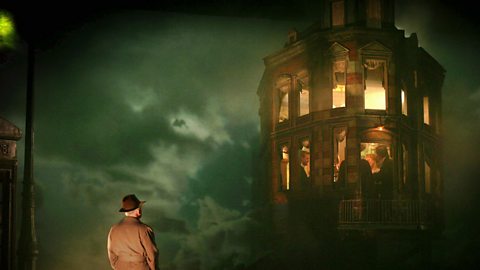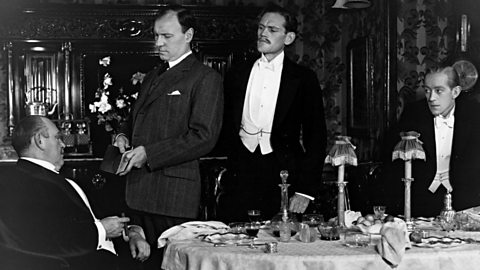Act I
Setting the scene and opening the play

Before the play begins, Priestley gives detailed instructions on how the play should be staged. The action takes place in a single room with few adjustments needed during the performance. The stage directions specify that the house is 'not cosy and homelike' and the lighting needs to become 'brighter and harder' once the Inspector arrives. The first of the three acts opens with the Birling family and Gerald Croft celebrating the engagement of Sheila Birling and Gerald.
Mr Birling makes a speech
As it is a happy occasion, Mr Birling takes the opportunity to make a speech. During the speech he reveals how happy he is that Sheila is marrying Gerald because Gerald’s parents are wealthy business owners. It is clear that Mr Birling feels this marriage will be to his advantage, he boasts that he is to be considered for a knighthoodAn honorary title given out by the monarch.. It is important to realise that the audience of 1945 would pick up on the fact that a lot of what Mr Birling says is incorrect. He states how war will never happen and that the Titanic is unsinkable. This would indicate to the audience that what Mr Birling says is not to be trusted. It might also alert them to a few other clues that Priestley gives in this opening scene that things are not as positive as they might appear in the Birling house. Eric Birling is distracted and a little drunk, while Sheila teases Gerald about him neglecting her last summer. During the speech, Mr Birling suggests that 'a man has to make his own way'. At this precise moment, Inspector Goole arrives.
Eva was sacked from the Birling factory

The Inspector tells the family that a girl died in the infirmary two hours ago. She took her own life by drinking disinfectant. The family are shocked by this news but don't see how they could be involved. The Inspector has a picture of the girl and a letter and diary she had written. He only ever shows one person the picture at a time - this is an important detail for later. He reveals the girl's name - Eva Smith, and that she used to work in Mr Birling's factory. Mr Birling had Eva sacked as she was the ringleader of a group of workers who had asked for higher pay. Mr Birling still can’t see how he has anything to do with Eva’s death. The Inspector points out that her being sacked could be the beginning of a chain of events that led to her suicide but Mr Birling is still not convinced.